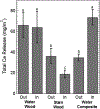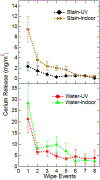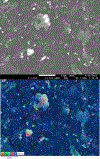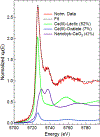Dermal transfer and environmental release of CeO2 nanoparticles used as UV inhibitors on outdoor surfaces: Implications for human and environmental health
- PMID: 28938214
- PMCID: PMC6738344
- DOI: 10.1016/j.scitotenv.2017.09.050
Dermal transfer and environmental release of CeO2 nanoparticles used as UV inhibitors on outdoor surfaces: Implications for human and environmental health
Abstract
A major area of growth for "nano-enabled" consumer products have been surface coatings, including paints stains and sealants. Ceria (CeO2) nanoparticles (NPs) are of interest as they have been used as additives in these these products to increase UV resistance. Currently, there is a lack of detailed information on the potential release, and speciation (i.e., ion vs. particle) of CeO2 NPs used in consumer-available surface coatings during intended use scenarios. In this study, both Micronized-Copper Azole pressure-treated lumber (MCA), and a commercially available composite decking were coated with CeO2 NPs dispersed in Milli-Q water or wood stain. Coated surfaces were divided into two groups. The first was placed outdoors to undergo environmental weathering, while the second was placed indoors to act as experimental controls. Both weathered surfaces and controls were sampled over a period of 6months via simulated dermal contact using methods developed by the Consumer Product Safety Commission (CPSC). The size and speciation of material released was determined through sequential filtration, total metals analysis, X-Ray Absorption Fine Structure Spectroscopy, and electron microscopy. The total ceria release from MCA coated surfaces was found to be dependent on dispersion matrix with aqueous applications releasing greater quantities of CeO2 than stain based applications, 66±12mg/m2 and 36±7mg/m2, respectively. Additionally, a substantial quantity of CeO2 was reduced to Ce(III), present as Ce(III)-organic complexes, over the 6-month experimental period in aqueous based applications.
Keywords: Ceria; Exposure; Nano-enabled; Nanomaterial; Surface coating; XAFS.
Published by Elsevier B.V.
Figures








References
-
- Al-Kattan A, Wichser A, Vonbank R, Brunner S, Ulrich A, Zuin S, et al. Characterization of materials released into water from paint containing nano-SiO2. Chemosphere 2015; 119: 1314–1321. - PubMed
-
- Al-Kattan A, Wichser A, Vonbank R, Brunner S, Ulrich A, Zuin S, et al. Release of TiO2 from paints containing pigment-TiO2 or nano-TiO2 by weathering. Environmental Science: Processes & Impacts 2013; 15: 2186–2193. - PubMed
-
- Auffan M, Masion A, Labille J, Diot M-A, Liu W, Olivi L, et al. Long-term aging of a CeO2 based nanocomposite used for wood protection. Environmental Pollution 2014; 188: 1–7. - PubMed
-
- Batley GE, Halliburton B, Kirby JK, Doolette CL, Navarro D, McLaughlin MJ, et al. Characterization and ecological risk assessment of nanoparticulate CeO2 as a diesel fuel catalyst. Environmental Toxicology and Chemistry 2013; 32: 1896–1905. - PubMed
-
- Castano CE, O’Keefe MJ, Fahrenholtz WG. Cerium-based oxide coatings. Current Opinion in Solid State and Materials Science 2015; 19: 69–76.
MeSH terms
Substances
Grants and funding
LinkOut - more resources
Full Text Sources
Other Literature Sources

